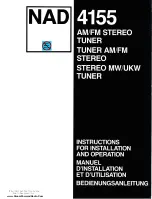
3
rd
Generation Compact RDMS
TM
Telemetry Receiver
18
Quasonix, Inc.
4.3 RDMS Serial Control Protocol
The Compact RDMS™ is controlled via a simple three-wire serial interface (transmit, receive, and ground).
Configure your controller’s serial port to the following settings:
•
Baud rate of 115,200
•
8 bits
•
No parity
•
1 stop bit
For setup and configuration via a standard Windows-based PC, Quasonix recommends the application called
Terminal
, a flexible, full-featured control interface that is included in the RDMS Product CD. Otherwise, one can
use HyperTerminal, included with the standard Windows installation (Start -> All Programs -> Accessories ->
Communications -> HyperTerminal).
When power is applied to the receiver, a welcome message, shown in Figure 5, displays. After the welcome
message, the mode status displays (in this example, PCM/FM). This varies depending on the modes and versions
loaded into the RDMS. Additional status information about RDMS initialization displays last. This also varies
depending on RDMS settings and options.
Quasonix, Inc
6025 Schumacher Park Dr
West Chester, OH 45069
(513) 942-1287
www.quasonix.com
CAGE CODE: 3CJA9
IRIG-106 Release 07
PCMFM App Rev: 1.0.10.166 Dec 3 2015 09:42:16
PCMFM FPGA Rev: 0000102E Nov 12 2015 02:34:51
AGC tables loaded
RF attenuator calibration loaded
IF attenuator calibration loaded
Gain calibration data loaded
RF filter tune data loaded
Synthesizer data loaded
Saved parameters DEFAULTED
Warm start>
Figure 8
: RDMS™ Welcome Message Example
All commands are one or two alphabetic characters, followed by 0, 1, or 2 arguments. If the command is issued with
arguments, there must be a space after the alphabetic characters. The commands are not case sensitive.
All commands generate a response of one or more lines. The length of the response depends on the verbosity level
(set by the VL command). The last response line is always the currently selected mode (PCM/FM, SOQPSK, CPM,
or PSK), followed by the character “+” or “>”, depending on the version of the firmware. This prompt signifies that
the RDMS is ready to accept new characters.
















































